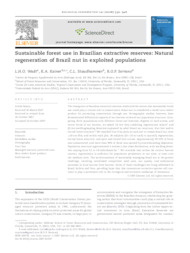Sustainable forest use in Brazilian extractive reserves: natural regeneration of Brazil nut in exploited populations.
Sustainable forest use in Brazilian extractive reserves: natural regeneration of Brazil nut in exploited populations.
Autoria: WADT, L. H. de O.; KAINER, K. A.; STAUDHAMMER, C. L.; SERRANO, R. O. P.
Resumo: The emergence of Brazilian extractive reserves reinforced the notion that sustainable forest use could play a central role in conservation. Brazil nut is considered a model non-timber product for promoting conservation through use. Demographic studies, however, have demonstrated differential impacts of nut harvest on Brazil nut population structure. Comparing three populations with different forest use histories, degrees of road access, and recent levels of nut harvest, we asked: (1) Are they exhibiting regeneration failure? and (2) Are seedling/sapling densities explained by adult Brazil nut structure, fruit fate and/or overall forest structure? We installed four 9-ha plots in each site to census Brazil nut trees > 10 cm dbh, and within each plot, 36 subplots (25 × 25 m each) to quantify regeneration, overall forest structure, and open and closed fruit counts. Approximately 29-55% of fruits was unharvested, and more than 90% of these was opened by scatterhoarding dispersers. Population structure approximated a reverse-J size class distribution, with seedling densities varying from 3.2 to 5.8 individuals ha-1. We conclude that within the current harvest context, regeneration is sufficient for population persistence in our sites, at least over the medium term. The socioeconomics of sustainably managing Brazil nut is the greater challenge, involving interlinked competitive land uses, nut quality, and substantial increases in local income from harvest. Some of these challenges are being addressed in Brazil, Bolivia and Peru, providing hope that this cornerstone extractive species will continue to play a prominent role in the ecological and economic landscape of Amazonia.
Ano de publicação: 2008
Tipo de publicação: Artigo de periódico
Unidade: Embrapa Acre
Palavras-chave: Bertholletia excelsa, Castanha do brasil, Castanha do pará, Extractive reserve, Manejo florestal, Nuez del Brasil, Productos forestales no madereros, Produto florestal não madeireiro (PFNM), Regeneración natural, Regeneração natural, Reserva extractiva, Reserva extrativista, Silvicultura sustentable
Observações
1 - Por padrão são exibidas publicações dos últimos 20 anos. Para encontrar publicações mais antigas, configure o filtro ano de publicação, colocando o ano a partir do qual você deseja encontrar publicações. O filtro está na coluna da esquerda na busca acima.
2 - Para ler algumas publicações da Embrapa (apenas as que estão em formato ePub), é necessário ter, no celular ou computador, um desses softwares gratuitos. Sistemas Android: Google Play Livros; IOS: iBooks; Windows e Linux: software Calibre.
Acesse outras publicações
Acesse a Base de Dados da Pesquisa Agropecuária (BDPA) para consultar o acervo completo das bibliotecas da Embrapa.

